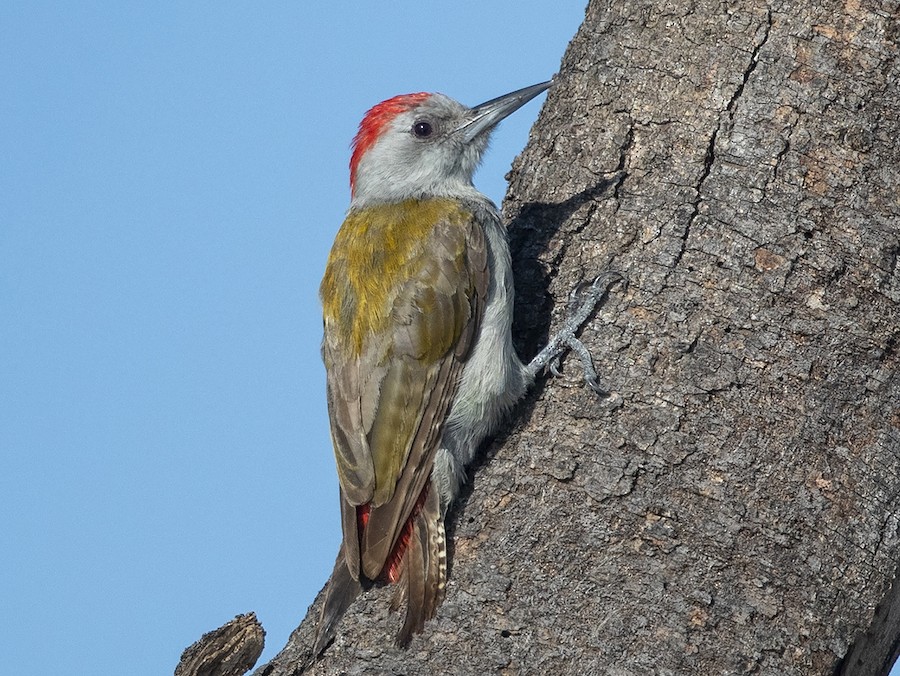
Grey Woodpecker
Grey Woodpecker
The Grey Woodpecker: Nature’s Elusive Drummer of the Forest
Introduction
The Grey Woodpecker is a captivating avian species that thrives in the wooded landscapes of sub-Saharan Africa. Known for its subtle plumage and rhythmic pecking, this bird plays a vital role in forest ecosystems. Despite its understated appearance, the Grey Woodpecker is a marvel of adaptation, intelligence, and ecological importance. In this comprehensive guide, we will explore its habitat, behavior, diet, conservation status, and the ecological impact it has on its environment.
What is the Grey Woodpecker?
The Grey Woodpecker, scientifically known as Dendropicos goertae, is a medium-sized bird belonging to the Picidae family. This species is often overshadowed by its more flamboyant cousins like the Pileated Woodpecker or the Northern Flicker, but it holds its own unique place in the avian world.
Key Characteristics:
- Scientific Name: Dendropicos goertae
- Family: Picidae
- Size: Approximately 20–23 cm in length
- Coloration: Predominantly grey with subtle greenish or brownish tinges
- Distinguishing Feature: Males have a small red patch on the crown
Habitat and Distribution
The Grey Woodpecker is predominantly found across the sub-Saharan region of Africa. Its range includes countries like Nigeria, Ghana, Cameroon, Sudan, and Uganda.
Preferred Habitats:
- Savannah Woodlands: Open forests with scattered trees
- Riverine Forests: Areas near water bodies with dense vegetation
- Agricultural Edges: Farmlands with remaining tree cover
- Urban Parks: Occasionally seen in city gardens and parks
This bird is highly adaptable and can thrive in both dry and moist environments, provided there is sufficient tree cover for foraging and nesting.
Behavioral Traits
The Grey Woodpecker is a solitary and elusive bird, often heard before it is seen. Its drumming and calls are distinctive, serving as communication tools and territorial markers.
Notable Behaviors:
- Drumming: Used to establish territory and attract mates
- Tree Climbing: Uses stiff tail feathers and zygodactyl feet for vertical movement
- Cavity Nesting: Excavates holes in dead or decaying trees for nesting
Unlike some woodpeckers that are aggressive or highly territorial, the Grey Woodpecker tends to be more reserved, avoiding confrontation and maintaining a low profile.
Diet and Foraging Habits
As an insectivore, the Grey Woodpecker plays a crucial role in controlling insect populations in its habitat.
Primary Diet:
- Ants and Termites: Extracted from tree bark using a long, sticky tongue
- Beetle Larvae: Dug out from decaying wood
- Spiders and Caterpillars
- Occasional Fruits and Berries
The bird uses its strong beak to chisel into wood and bark, often leaving behind characteristic holes that can be used by other species for shelter or nesting.
Reproduction and Lifespan
Breeding season varies by region but generally coincides with the rainy season when food is abundant.
Reproductive Details:
- Nesting: In tree cavities, usually 3–10 meters above ground
- Clutch Size: 2–4 eggs
- Incubation Period: Around 12–14 days
- Parental Care: Both parents share incubation and feeding duties
The Grey Woodpecker can live up to 7–10 years in the wild, depending on environmental conditions and predation risks.
Ecological Importance
The Grey Woodpecker is more than just a forest dweller—it is a keystone species in its ecosystem.
Ecological Roles:
- Pest Control: Reduces insect infestations in trees
- Habitat Creation: Abandoned nests provide shelter for other birds and small mammals
- Seed Dispersal: Occasionally contributes by consuming and excreting seeds
By maintaining the health of trees and contributing to biodiversity, this bird supports the overall balance of its habitat.
Conservation Status
According to the IUCN Red List, the Grey Woodpecker is currently listed as a species of Least Concern. However, this does not mean it is free from threats.
Threats to Survival:
- Deforestation: Loss of nesting and foraging sites
- Urban Expansion: Habitat fragmentation
- Pesticide Use: Reduces insect prey availability
- Climate Change: Alters habitat conditions and food sources
Conservation Measures:
- Protected Areas: National parks and reserves
- Community Awareness: Educating locals on the bird’s importance
- Sustainable Forestry: Encouraging eco-friendly logging practices
Grey Woodpecker vs. Other Woodpeckers
While the Grey Woodpecker may not be as visually striking as other species, it has unique traits that set it apart.
| Feature | Grey Woodpecker | Pileated Woodpecker | Northern Flicker |
|---|---|---|---|
| Size | Medium | Large | Medium |
| Color | Grey with red crown (males) | Black with red crest | Brown with black bars |
| Range | Sub-Saharan Africa | North America | North America |
| Diet | Insects, ants, termites | Insects, fruits | Ants, beetles |
How to Spot a Grey Woodpecker
If you’re birdwatching in Africa, spotting a Grey Woodpecker can be a rewarding experience.
Tips for Identification:
- Listen for Drumming: A rapid, rhythmic tapping on wood
- Look for Movement: Vertical climbing on tree trunks
- Check Tree Cavities: Possible nesting sites
- Use Binoculars: To observe subtle coloration and behavior
Cultural Significance
In some African cultures, woodpeckers are seen as symbols of persistence and rhythm. While the Grey Woodpecker is not as mythologized as other birds, its presence is often associated with forest health and natural harmony.
How You Can Help
Even if you don’t live in Africa, you can contribute to the conservation of the Grey Woodpecker and similar species.
Ways to Support:
- Donate to Conservation Groups: Like BirdLife International
- Support Reforestation Projects
- Promote Eco-Tourism
- Educate Others: Share articles and raise awareness
Frequently Asked Questions (FAQ)
1. Where can I find the Grey Woodpecker?
The Grey Woodpecker is native to sub-Saharan Africa, commonly found in savannahs, riverine forests, and wooded farmlands.
2. What does the Grey Woodpecker eat?
It primarily feeds on insects, especially ants and termites, but may also consume fruits and berries.
3. Is the Grey Woodpecker endangered?
No, it is currently listed as a species of Least Concern by the IUCN, but habitat loss remains a threat.
4. How does it differ from other woodpeckers?
Unlike more colorful species, the Grey Woodpecker has a subtle grey plumage and is more elusive in behavior, often avoiding human interaction.
5. Can I attract Grey Woodpeckers to my garden?
If you live within its range, planting native trees and avoiding pesticides can create a welcoming environment for this species.
Conclusion
The Grey Woodpecker may not dazzle with vibrant colors, but its ecological importance, unique behaviors, and adaptability make it a fascinating subject for bird enthusiasts and conservationists alike. As forests face increasing threats, understanding and protecting such species becomes ever more crucial. By appreciating birds like the Grey Woodpecker, we take a step closer to preserving the intricate web of life that sustains our planet.
